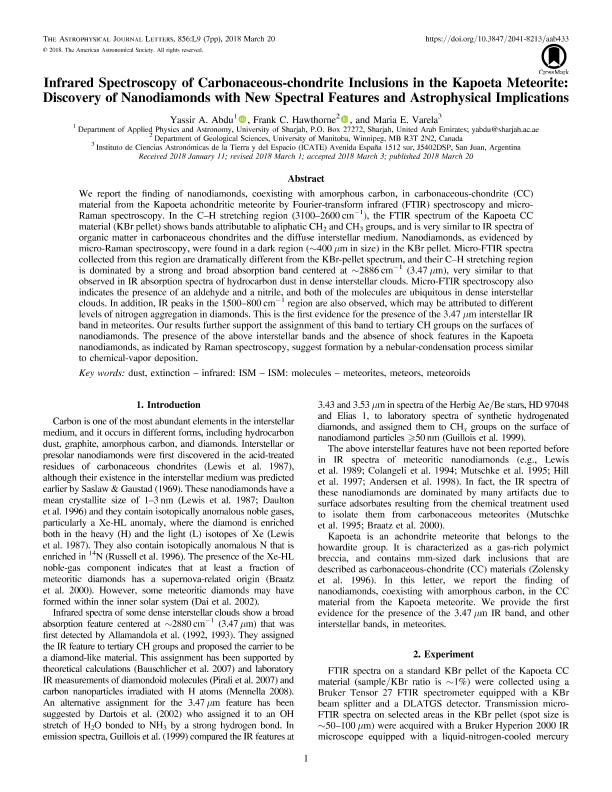Mostrar el registro sencillo del ítem
dc.contributor.author
Abdu, Yassir A.
dc.contributor.author
Hawthorne, Frank C.
dc.contributor.author
Varela, Maria Eugenia

dc.date.available
2020-05-22T20:14:41Z
dc.date.issued
2018-03-22
dc.identifier.citation
Abdu, Yassir A.; Hawthorne, Frank C.; Varela, Maria Eugenia; Infrared Spectroscopy of Carbonaceous-chondrite Inclusions in the Kapoeta Meteorite: Discovery of Nanodiamonds with New Spectral Features and Astrophysical Implications; IOP Publishing; Astrophysical Journal Letters; 856; 1; 22-3-2018; 1-7
dc.identifier.issn
2041-8205
dc.identifier.uri
http://hdl.handle.net/11336/105810
dc.description.abstract
We report the finding of nanodiamonds, coexisting with amorphous carbon, in carbonaceous-chondrite (CC) material from the Kapoeta achondritic meteorite by Fourier-transform infrared (FTIR) spectroscopy and micro-Raman spectroscopy. In the C-H stretching region (3100-2600 cm-1), the FTIR spectrum of the Kapoeta CC material (KBr pellet) shows bands attributable to aliphatic CH2 and CH3 groups, and is very similar to IR spectra of organic matter in carbonaceous chondrites and the diffuse interstellar medium. Nanodiamonds, as evidenced by micro-Raman spectroscopy, were found in a dark region (¡400 ¥ìm in size) in the KBr pellet. Micro-FTIR spectra collected from this region are dramatically different from the KBr-pellet spectrum, and their C-H stretching region is dominated by a strong and broad absorption band centered at ¡2886 cm-1 (3.47 ¥ìm), very similar to that observed in IR absorption spectra of hydrocarbon dust in dense interstellar clouds. Micro-FTIR spectroscopy also indicates the presence of an aldehyde and a nitrile, and both of the molecules are ubiquitous in dense interstellar clouds. In addition, IR peaks in the 1500-800 cm-1 region are also observed, which may be attributed to different levels of nitrogen aggregation in diamonds. This is the first evidence for the presence of the 3.47 ¥ìm interstellar IR band in meteorites. Our results further support the assignment of this band to tertiary CH groups on the surfaces of nanodiamonds. The presence of the above interstellar bands and the absence of shock features in the Kapoeta nanodiamonds, as indicated by Raman spectroscopy, suggest formation by a nebular-condensation process similar to chemical-vapor deposition.
dc.format
application/pdf
dc.language.iso
eng
dc.publisher
IOP Publishing

dc.rights
info:eu-repo/semantics/openAccess
dc.rights.uri
https://creativecommons.org/licenses/by-nc-sa/2.5/ar/
dc.subject
DUST, EXTINCTION
dc.subject
INFRARED: ISM
dc.subject
ISM: MOLECULES
dc.subject
METEORITES, METEORS, METEOROIDS
dc.subject.classification
Astronomía

dc.subject.classification
Ciencias Físicas

dc.subject.classification
CIENCIAS NATURALES Y EXACTAS

dc.title
Infrared Spectroscopy of Carbonaceous-chondrite Inclusions in the Kapoeta Meteorite: Discovery of Nanodiamonds with New Spectral Features and Astrophysical Implications
dc.type
info:eu-repo/semantics/article
dc.type
info:ar-repo/semantics/artículo
dc.type
info:eu-repo/semantics/publishedVersion
dc.date.updated
2020-04-28T16:12:44Z
dc.journal.volume
856
dc.journal.number
1
dc.journal.pagination
1-7
dc.journal.pais
Reino Unido

dc.journal.ciudad
London
dc.description.fil
Fil: Abdu, Yassir A.. American University of Sharjah. Department of Physics; Emiratos Árabes Unidos
dc.description.fil
Fil: Hawthorne, Frank C.. University of Manitoba; Canadá
dc.description.fil
Fil: Varela, Maria Eugenia. Consejo Nacional de Investigaciones Científicas y Técnicas. Centro Científico Tecnológico Conicet - San Juan. Instituto de Ciencias Astronómicas, de la Tierra y del Espacio. Universidad Nacional de San Juan. Instituto de Ciencias Astronómicas, de la Tierra y del Espacio; Argentina
dc.journal.title
Astrophysical Journal Letters
dc.relation.alternativeid
info:eu-repo/semantics/altIdentifier/doi/http://dx.doi.org/10.3847/2041-8213/aab433
dc.relation.alternativeid
info:eu-repo/semantics/altIdentifier/url/https://iopscience.iop.org/article/10.3847/2041-8213/aab433
Archivos asociados
